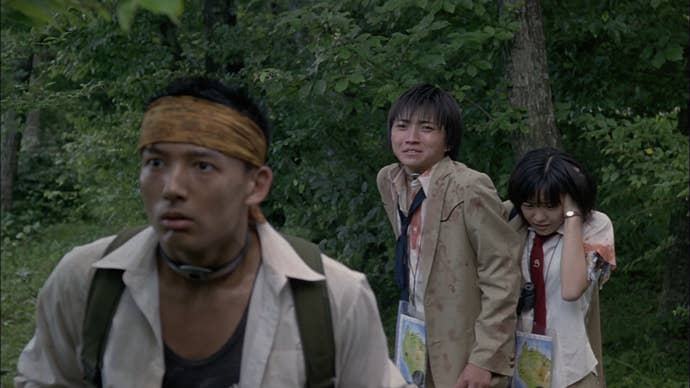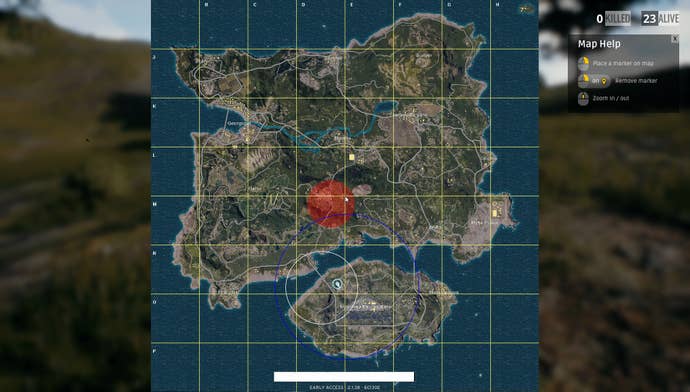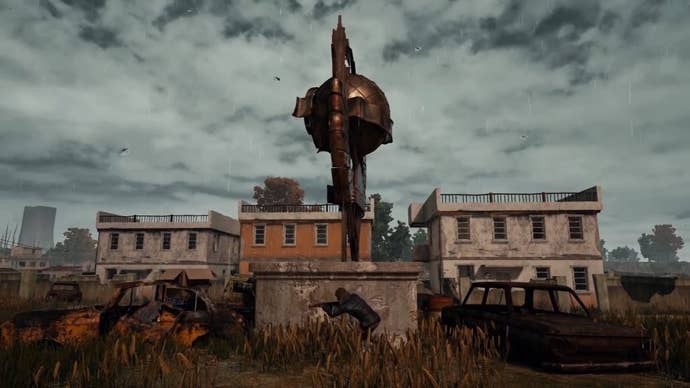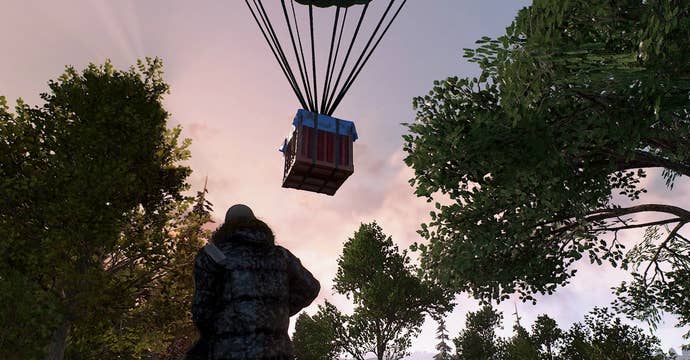Meeting PlayerUnknown, and the Fiction that Inspired the Year's Biggest Surprise Hit
Talking to the known player himself Brendan Greene about the influences of Battle Royale, and the future of PlayerUnknown's Battlegrounds.
This article first appeared on USgamer, a partner publication of VG247. Some content, such as this article, has been migrated to VG247 for posterity after USgamer's closure - but it has not been edited or further vetted by the VG247 team.
There's a particular moment of pure, bloody chaos in Battle Royale where a group of teenage girls slaughter each other in the blink of an eye. Before that moment, they were the best of friends, hiding out in a desolate lighthouse. It was their makeshift home in this temporary hell. A hell where everyone was pitted against one another to fight to the death until only one remained.
The young girls were living peacefully before this moment. Or at least, as peacefully as possible in their situation. That peace lasts until someone thinks to poison their injured male guest. A girl, by mistake, eats some of the poisoned food before promptly keeling over. The death seeds distrust, and then bloodlust. Nearly everyone in the room dies in a matter of moments. A gun emerges. Blood spills. Bodies fall. It's tense, unexpected, and distressing; every person flipping their relationships to focus on their own survival. In essence, it's just like a round of the video game PlayerUnknown's Battlegrounds.
It's an unsettling scene in an unsettling piece of fiction. The work, a weighty novel from author Koushun Takami that was later popularized by filmmaker Kinji Fukasaku, would come to inspire a new genre of video games entirely. "[I've only seen] the movie," Brendan "PlayerUnknown" Greene, creative director behind this year's surprise smash PlayerUnknown's Battlegrounds, said over Skype. "I never got around to reading the book. I feel a little bit ashamed for that actually."

Greene's recently become the face of Battle Royale. Not for the one we've experienced across Japanese literature, film, and manga, but a new kind. An actively gamified Battle Royale that captures the same tone of intensity, of distrust, of bloodshed. His debut, non-mod game PlayerUnknown's Battlegrounds has had a ripple effect in the gaming community. In Early Access, it's already sold an astounding five million copies to date, and the game only continues to grow more expansive.
Greene isn't the first person to make a last-person-standing game, and he won't be the last. Yet somehow, he's become the face of the Battle Royale-like genre through his mods and now with Battlegrounds. When people utter the words Battle Royale, it wouldn't be too far off to imagine the moniker PlayerUnknown appearing alongside it as well.
Before modding himself, Greene had been a fan of other games with similar ideas, like the DayZ mod Survivor Gamez designed by Brian Hicks and Jordan Tayer. The Survivor Gamez mod dubs itself as the "original survival gaming competition," a last-team-standing mode. Greene was a fan and wanted to make something similar. But Survivor Gamez already existed, was heavily guided, and Greene wanted to do something different. "It just kind of came to me. Like, f**k, Battle Royale," said Greene. "I loved that movie growing up. I went back and I watched it and thought, okay, let's design it around that rather than a team-based competition which the Survivor Gamez was."

At this point, Greene's unlikely road to helping create the top game on Steam and Twitch is fairly known. He was essentially a nobody before Battlegrounds' smash success, well known in modding communities, but not much else. Before diving into the modding communities of DayZ and ArmA in his free time, he was a globetrotting web designer and photographer by day, hailing originally from Ireland. Feeling emboldened by the DayZ Survivor Gamez mod, Greene knew what he wanted to do: he wanted to make his own mod. Or rather, materialize his dream way to play.
"I love the concept, you know? It's just every person against themselves," said Greene. "In the movie, especially when temporary bonds form. You see that quite a lot in our game. Someone will form a temporary bond with [someone else], but end up killing them ten seconds later. This kind of idea that you can't trust anyone, you always need to be watching your shoulder. The movie portrayed that exceedingly well." Greene hopes his game does too. (It does.)
Thus, one of the first iterations of Battle Royale was born in the confines of ArmA 2 and 3, a hyper realistic military simulator. When I called it a very "serious" type of game contrary to his work with H1Z1 and Battlegrounds, Greene emphatically agreed. Initially for a DayZ Battle Royale mod he worked on, the angle was more focused on emulating The Hunger Games, a series of young adult novels by Suzanne Collins that share more than a cursory influence from Battle Royale. In that theorized mode, everyone would be placed in a circle with "a central cornucopia full of stuff." Greene ended up moving away from this to the ejecting out of a plane model we know today. Partially due to "copyright issues" in regards to The Hunger Games name, but mostly due to giving players a better chance of stocking up on gear, and most importantly: staying alive.

There was another change away from the movie-like adaptation Greene was going for. In Battle Royale, across the island are many defined squares that characters must stay within or travel toward. "Squares, to actually write in code, are quite difficult," said Greene. "Well, for [someone] who doesn't have a lot of experience programming. So that's why we have the ever-decreasing circle... because of my lack of knowledge in programming." The players in Battlegrounds don't wear collars like in Battle Royale either, but falling outside of the circle spells damage for the unlucky who can't crawl within the white sphere in time.
Later, Greene went on to lead H1Z1's popular King of the Kill, a Battle Royale-like mode in the skin of another PvP game. That project is what led to the current Greene: the PlayerUnknown everyone knows, talking to me now from his new home in South Korea as he works within Bluehole Inc. on the present and future of PlayerUnknown's Battlegrounds. Greene's made leaps and bounds his entire life in terms of his professions, but at last, after years of dabbling in his spare time, he's finally made the largest leap of all. The jump to being a creative director on a now-major video game.
Battlegrounds, true to Greene's vision, falls somewhere between those name-defining projects. "I had a lot of H1 fans of King of the Kill [saying copy King of the Kill], and a lot of the ArmA fans going 'well, copy ArmA.' It was never my intention to do either, because they exist," said Greene. "If you want to play the super realistic one you go ArmA 3, and if you want to play a more arcadey shooter, you play King of the Kill. I want to get somewhere inbetween that had that ease of play of King of the Kill, but had the depth of loot and attachments that ArmA has."
It was never my intention to do [ArmA or King of the Kill again], because they exist.
The Battlegrounds that exists now in Early Access is a small game. A single map. A single mode. With a few more weapons and weather changes thrown in on a monthly update basis. For the locale dubbed Erangel, the map's a cluttered mixture of weird spaces. In one area, you'll find a partially submerged town. In another, desolate ruins. The map of Erangel often feels like the bits of other places stitched together, to make the disjointed quilt that is Battlegrounds' primary map.
"[Everyone] here in Bluehole has never done a realistic map before," said Greene. "They're basically MMO creators and have done more fantasy stuff. With our first map, I think PC Gamer said it looks like a massive paintball map that someone created rather than this realistic space. And you know, I agree. There's volcanic rock in the middle of fields and stuff, which really shouldn't be there. But the map plays well, and that's the main thing."
Battlegrounds is expanding for its eventual full release outside of Early Access though, with two more maps on the horizon. For the additional maps, Greene promises they'll be a lot more cohesive than the confusing footsteps on walls of graffiti you may find in a house or two in Battlegrounds now. "With our new maps, we have guys that really have a lot of experience creating realistic maps," said Greene. "We have a level designer who worked on Call of Duty. Our other lead terrain artist here in Korea loves that realism and spends hours reading books on the trees of regions and all this kind of stuff. So the next map should feel a lot realer, a lot more together. And it's our plan in maybe a year's time to go back to Erangel and sort of remake the map and give it that identity of this kind of Russian or Crimean island, I should say."


By the rules it suggests, Battle Royale presents a sick and twisted game of its own, laying the groundwork for an interactive version of it to come decades later. It's a harrowing scenario, with a variety of students in a random class being sent to murder each other on a lonely island away from society. And if they don't want to, they run the risk of their heads being blown off by an explosive choker. As the students skip away from their starting spot, they're handed lunch bags as they're sent on their merry way—brown paper bags with a random "weapon" within it. That "weapon" can be anything from an axe to a pot lid, just like the loot players gather in Battlegrounds.
In Takami's novel, most characters are given their due in a chapter or two in ways the film can't really deliver with its short runtime. In the novel, we meet a sweet-natured young couple who make the decision to dive off a cliff at the start of the mishap. We meet a troubled girl who unnervingly embraces the murderous chaos. The novel, unlike the movie, brings its dozens of characters to life before they inevitably meet death. Every character is the star of their own story, just like the players in the nightmarish one-versus-one-versus-one-versus-many-more.
In the Battle Royale-style games like Battlegrounds that we now know and love, we're tasked like the unassuming characters in Battle Royale. The game asks us a simple question: what would you do in this situation? Some players harbor sneaky tactics, hiding out in decrepit bedrooms with a shotgun for emergencies. Others are more brutal, the type to run towards red-smoking crates in a frenzy. As Greene told me, he "wanted to test the player for their tactical and strategic thinking rather than how fast they were at pulling a trigger." Scanning the leaderboards for Battlegrounds, Greene notes that these players exemplify that gift. They're quick on their toes, unafraid to shift their tactics and counter combatants. That is what sets them apart, just like the wedge between the most stealthy and violent characters of Battle Royale.
"There's already people role-playing in Battle Royale servers, which really just made me think, 'how do you roleplay during Battle Royale?' But they find their ways," said Greene. "In our custom games, we want to foster this idea that people will come up with their own ideas for game modes. You saw that Grand Theft Auto V [Online] roleplaying just really took off over the last few months. So we want to really foster that by giving everyone a big playground to play in with lots of weapons, lots of items, different clothing sets. A good selection of assets basically for them to create their own stories within the game."

Battlegrounds' roleplaying hopes are one step closer now with the recent release of paid Battle Royale-inspired skins (a timed special in accordance with the upcoming debut Battlegrounds Invitational competition). The outfits now available in Invitational-themed loot crates range from the tracksuit of the villainous Kitano to a schoolgirl uniform from the students in Battle Royale.
Greene, at least from my perspective, has captured the heart and intensity of Battle Royale swimmingly across his many mods. Its purest distillation is what we find now in Battlegrounds, a game at once accessible yet with a layer of depth for all players to dive into. For Greene, fame wasn't part of the plan though. He just wanted to make a solid game mode and give back to the player community that supported him so avidly in his modding days.
"There were a lot of mods at the time of releasing DayZ Battle Royale that had started to monetize and start in-game shops to buy in-game items," said Greene. "From a modding point of view, I thought that was a bit wrong. Now I understand that servers cost money, but a lot of them took it to very much an extreme where it seemed like a money grab. So I wanted to give a mod that again, was purely free, back to the community. Even to this day, I pay for the ArmA 3 servers out of my own pocket, which sometimes runs me two grand every month to pay for servers. But honestly, I don't mind doing that because they've given me so much. I feel like it's my duty to give them those servers to play on for free."

Onwards, Battlegrounds has a long road ahead to full release. But being a service rather than a game-game, Greene intends to support Battlegrounds for the long run. In the meantime, the end of this month sees a big, exciting event for Battlegrounds: their first Invitational competition, with 80 players competing at Gamescom on August 23 to 26. Esports has always been the sparkle in Greene's eye, even with its potential being a logistical nightmare (and the impossibility of flying out a hundred or less people).
"As much as I love watching esports like Counter-Strike: Global Offense and the others, it's still just two teams of five on a stage," said Greene. "I want to create a spectacle. You know, 64 players in an arena, fighting out against each other. I want that idea that this is a massive number of people supported by a massive crowd."
The promise of an esports future for the Battle Royale genre only loops back into the game of Battle Royale itself: a deadly one, where only one champion prevails. Even if they feel a bit grimy about the blood on their hands along the way. "This is why we have our custom games. We want to give players the ability to start their own leagues from the ground up, and really start building a community of Battle Royale players. Amateur as they are now, trying to build that pyramid up to the top of having a major. We want to take things slowly, but we want to make sure we do it right."

